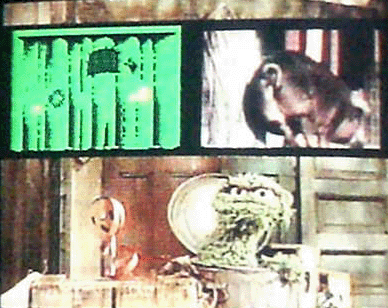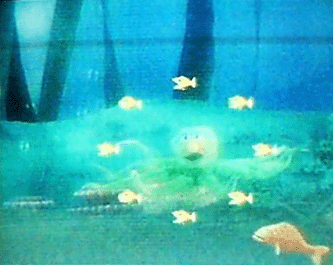The Interactive Vision is God’s way of assuring us that crazy people can make videogame consoles, too. I spoke about the system in some depth last month in Dear Readers, but for those of you drawn in by Michael Gray’s new reader drive, here’s a quick recap: It’s from the 80s, it’s geared toward children, and, unlike any natural videogame system, its games are all on VHS tapes,1 instead of discs or cartridges. Most games for the system are series of minigames that work by superimposing primitive graphics onto video footage, and Oscar’s Letter Party follows in suit, for the most part.
That’s the first minigame you play in OLP, and wow, if that cursor was any slower, it’d be a hardcore Madden fan. (It’s OK—Madden fans don’t read GameCola. Why would they need to read videogame reviews when Madden is the only game they ever play.) Controls aside, you have to admit that Oscar’s running commentary about removing all the happiness from his life makes this game a winner before you even figure out what the plot is.
Plot! No, I’m not being jocose—this game genuinely has one. Oscar’s throwing a party, and he kind of sort of wants you to go, but only if you can show that you hate life as much as him. Bob2 is throwing a party, too, though he doesn’t need you to prove yourself, and somewhere therein lies this game’s conflict.
Whose party are you going to go to?
Oscar wants you to play some minigames so he can determine your level of grouchiness, and you can’t object. Even if you really, really don’t want to to Bob’s stupid party, with his stupid vanilla ice-cream (see above), and would rather get your groove on with Oscar and his slime-tossing and his fish decor.3
One minigame asks you to spell out a word. You’re given a choice of two letters, then again, then again. The word I spelled was “rat.” I think I know which party I’m going to! Another game presents you with three sets of two things, and asks you to choose which you prefer. For example, I had to say whether I preferred pigs, or butterflies. I choose pigs, and then—this I found to be technologically impressive—Oscar played a video of pigs on TOP of the already-present Oscar footage. It looked like this:
How on earth did they do that?! My mind is still boggled.
A third minigame, another deciding factor in whose party I’d go to—and easily the best thing ever—went like this:
You can’t see this in the video, because my camera wasn’t focused on it, but I’m in the background, shaking, trying not to ruin my footage with an ill-timed LOL. My girlfriend, too, is in the background, but she’s looking around awkwardly, hoping no one can see. I had a lot of fun with this minigame.
And do you want to hear something really impressive? I had to stop the tape shortly after this minigame, because my camera’s memory card filled up. When I started the game up again, somehow, the game still remembered my answers from earlier in the game. I’m actually shocked in general that it can remember any of my answers beyond the time it takes to me to input them, but for me to be able to turn the game off, turn it back on, rewind a little bit and STILL not lose any information? That’s pretty awesome.
However, while the above was a clear good time, some of the other minigames really drag OLP down. For example, there’s this one that went on for about three minutes that had me watching a scene with an octopus and just pushing a button whenever he said the word “eight.” When I did so, some stuff would show up on the screen and then float away. There’s a similar minigame later where you watch Kermit sing along with bagpipe music, and you have to push a button whenever he says the word “frog” to make some frogs appear. If I were four years old, I guess that could’ve helped me develop my listening skills, but I think I could’ve also come up with more fun ways to spend my time, like choke-slamming people.
Then there are two—TWO!—minigames where you just watch a cartoon of the alphabet, and push a button when a letter you chose earlier in the game comes up. I chose “F,” and it was still boring as hell. No, wait, hell’s not boring. It was still boring as…science. And none of these four minigames even had any impact on the storyline! What’s the point. I have to admit, playing those games left me pretty disappointed, after the awesome creativity exhibited in the above singing minigame.
I will say, though, that even the boring minigames have something going for them, and that something is: Sesame Street footage. Even if the part where you actually interact with the system isn’t all that great, you can still have fun watching the clips.
There are a few more minigames, too. One had me controlling a frog and jumping around, trying to catch flies while Kermit sang in the background, and one had me lining up a digitized arrow with an arrow that kept moving around on the Grover clip that was showing. I can only talk about these for so long, though, before I remember that reviews have to talk about other things, too. So here goes my attempt to make this into a semi-normal review, instead of just describing every little thing you do in the game.
My problem is that there’s virtually nothing to say about either the graphics or the sound. The digital graphics are crappy, but that’s in line with the system’s capabilities, and the video quality clearly looks better than anything you could’ve gotten on any system of the era. The sound…same deal. The controls? Well, the one time I had to move a cursor around, the cursor was real slow, but other than that, I’m generally just pushing a button when I’m supposed to, and that always worked great.
Replay value, though! Replay value, I have some comments. This game is roughly fifteen years ahead of its time in at least one respect: It has alternate endings. Two, to be precise: One in which you visit Bob’s party, and one in which you visit Oscar’s party, and which ending you get is based entirely on your actions in the minigames. You have to admit, for 1988, that’s pretty awesome.
SPOILER ALERT! Here’s the grouch party ending:
The game only lasts a half-hour (the length of the tape), so it would probably be worthwhile to try for that second ending later on. And, actually, you can just fast-forward through the minigames you don’t like, too, and only play the ones you had a good time with the first time. Wouldn’t that be an awesome feature to be implemented in today’s games? Level skipping? Forget just level skipping. I’m only going to play only the parts of levels that I actually like. And can you imagine being able to fast-forward through boring random encounters in RPGs? Awesome.
With its alternate endings, its ability to skip through the parts of it you don’t like, and its having a storyline, Oscar’s Letter Party is a pretty creative game for 1988. And hey! It’s an educational game that a kid might actually want to play. (Or might have wanted to play, anyway—I don’t think I can see kids wanting to play this in 2008.) The nature of the system allows for a more accurate videogame representation of the TV show than you’d see in, say, an NES Sesame Street game, and, well, I’d rather watch clips and have some goofy interactions with them than play through a quarter-assed side-scroller. I won’t go so far as to say that View-Master‘s Interactive Vision was an awesome system that never should’ve died, but whoever put this game together, at least, had some really great ideas. (S/he had some terrible ideas, too, insofar as the alphabet minigames are concerned, but s/he also had some great ones.)
I’ve got more of these videogames/tapes lying around, so if you want another review…please don’t say anything, because that footage was REALLY hard to take.
1. How young are our readers? Do I have to explain what these are?
2. Remember Bob? Here’s what he’s up to now.
3. Really, I was just upset with Bob because he made me sound like such an asshole for wanting to go to Oscar’s party instead of his.
4. Did you think I was just being random when I mentioned the slime-tossing and the fish decor?



